Exmark Quest SP Models 00 Higher, Quest SP 850 User Manual
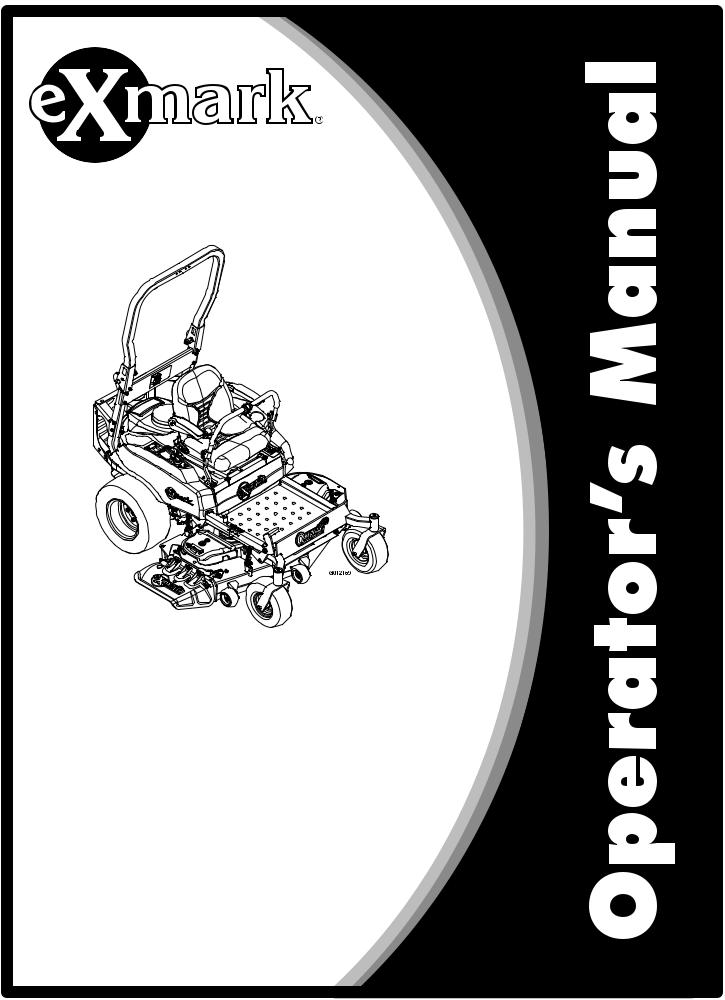
QUEST® SP MODELS
For Serial Nos.
850,000 & Higher
Part No. 4500-582 Rev. A
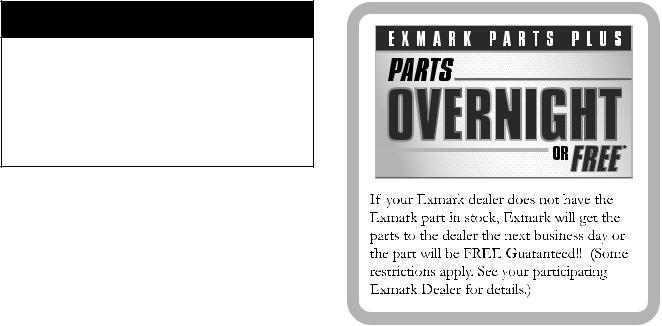
 WARNING
WARNING
CALIFORNIA
Proposition 65 Warning
The engine exhaust from this product contains chemicals known to the State of California to cause cancer, birth defects, or other reproductive harm.
Important: The engine in this product is not equipped with a spark arrester muffler. It is a violation of California Public Resource Code (CPRC) Section 4442 to use or operate this engine on any forest-covered, brush-covered, or grass-covered land as defined in CPRC 4126. Other states or federal areas may have similar laws.
To acquire a spark arrester for your unit, see your Engine Service Dealer.
This spark ignition system complies with Canadian ICES-002 Ce système d’allumage par ètincelle de vèhicule est conforme à la norme NMB-002 du Canada.
The enclosed Engine Owner’s Manual is supplied for information regarding The U.S. Environmental Protection Agency (EPA) and the California Emission Control Regulation of emission systems, maintenance and warranty.
Keep this engine Owner’s Manual with your unit. Should this engine Owner’s Manual become damaged or illegible, replace immediately. Replacements may be ordered through the engine manufacturer.
Exmark reserves the right to make changes or add improvements to its products at any time without incurring any obligation to make such changes to products manufactured previously. Exmark, or its distributors and dealers, accept no responsibility for variations which may be evident in the actual specifications of its products and the statements and descriptions contained in this publication.
© 2010—Exmark Mfg. Co., Inc. |
|
Contact us at www.Exmark.com. |
|
Industrial Park Box 808 |
|
Printed in the USA |
|
2 |
|||
Beatrice, NE 68310 |
All Rights Reserved |
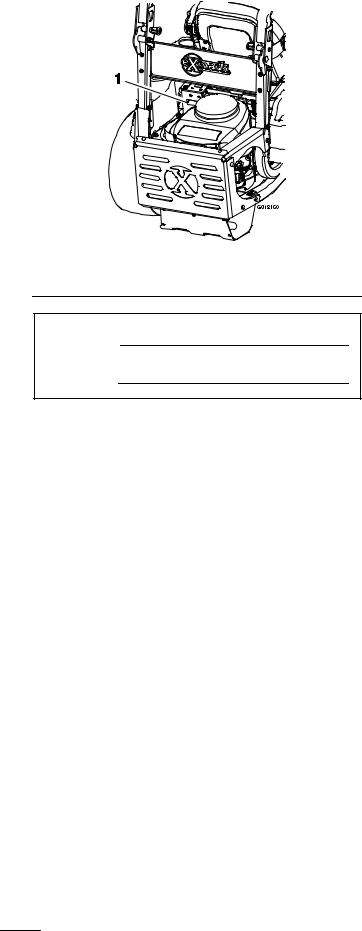
Introduction
CONGRATULATIONS on the purchase of your Exmark Mower. This product has been carefully designed and manufactured to give you a maximum amount of dependability and years of trouble-free operation.
This manual contains operating, maintenance, adjustment, and safety instructions for your Exmark mower.
BEFORE OPERATING YOUR MOWER, CAREFULLY READ THIS MANUAL IN ITS ENTIRETY.
By following the operating, maintenance, and safety instructions, you will prolong the life of your mower, maintain its maximum efficiency, and promote safe operation.
If additional information is needed, or should you require trained mechanic service, contact your authorized Exmark equipment dealer or distributor. Exmark parts manuals are available online at http://www.exmark.com/manuals.htm.
All Exmark equipment dealers and distributors are kept informed of the latest methods of servicing and are equipped to provide prompt and efficient service in the field or at their service stations. They carry ample stock of service parts or can secure them promptly for you from the factory.
All Exmark parts are thoroughly tested and inspected before leaving the factory, however, attention is required on your part if you are to obtain the fullest measure of satisfaction and performance.
Whenever you need service, genuine Exmark parts, or additional information, contact an Authorized Service Dealer or Exmark Customer Service and have the model and serial numbers of your product ready.
Figure 1 identifies the location of the model and serial numbers on the product. Write the numbers in the space provided.
Figure 1
1. Model and serial number location
Model No.
Serial No.
3

Contents |
|
Introduction ........................................................... |
3 |
Safety ..................................................................... |
5 |
Safety Alert Symbol......................................... |
5 |
SafeOperatingPractices.................................. |
5 |
SafetyandInstructionalDecals ..................... |
11 |
Specifications ....................................................... |
16 |
Model Numbers............................................ |
16 |
Systems......................................................... |
16 |
Dimensions................................................... |
17 |
Torque Requirements .................................... |
18 |
Product Overview ................................................ |
18 |
Operation ............................................................. |
19 |
Controls........................................................ |
19 |
Pre-Start........................................................ |
21 |
Operating Instructions .................................. |
22 |
Transporting ................................................. |
26 |
Maintenance ......................................................... |
28 |
RecommendedMaintenanceSchedule(s) ........... |
28 |
Periodic Maintenance ....................................... |
29 |
CheckEngineOilLevel................................. |
29 |
Check Mower Blades..................................... |
30 |
CheckSafetyInterlockSystem ....................... |
31 |
Check Rollover Protection System (Roll |
|
Bar) Knobs................................................ |
32 |
Check Seat Belt.............................................. |
32 |
CheckforLooseHardware............................ |
32 |
Service Air Cleaner........................................ |
32 |
ChangeEngineOilandFilter......................... |
32 |
CheckHydraulicOilLevel............................. |
32 |
Check Tire Pressures ..................................... |
33 |
CheckConditionOfBelts.............................. |
33 |
LubricateGreaseFittings............................... |
33 |
Check Spark Plugs......................................... |
33 |
Change Fuel Filter......................................... |
33 |
Change Hydraulic System Filter and |
|
Fluid ......................................................... |
33 |
CheckSparkArrester(ifequipped)................. |
34 |
ThreadLockingAdhesives............................. |
35 |
Copper-BasedAnti-seize .............................. |
35 |
Dielectric Grease........................................... |
35 |
Adjustments ..................................................... |
35 |
Deck Leveling ............................................... |
35 |
AdjustingtheBladeSlope.............................. |
36 |
PumpDriveBeltTension............................... |
37 |
Deck Belt Tension ........................................ |
37 |
AdjustingtheParkingBrake........................... |
37 |
MotionControlHandleAdjustment .............. |
38 |
FullForwardTrackingAdjustment................. |
39 |
AdjustingtheSeatRideSuspension................ |
39 |
ElectricClutchAdjustment............................ |
39 |
Cleaning ........................................................... |
41 |
Clean Engine and Exhaust System |
|
Area.......................................................... |
41 |
RemoveEngineShroudsandCleanCooling |
|
Fins........................................................... |
41 |
CleanHydroFanCoolingFins....................... |
41 |
CleanDebrisFromMachine.......................... |
41 |
CleanGrassBuild-UpUnderDeck ................ |
41 |
Waste Disposal.............................................. |
42 |
Troubleshooting ................................................... |
43 |
Schematics ........................................................... |
45 |
4

Safety
Safety
Safety Alert Symbol
This Safety Alert Symbol (Figure 2) is used both in this manual and on the machine to identify important safety messages which must be followed to avoid accidents.
This symbol means: ATTENTION! BECOME
ALERT! YOUR SAFETY IS INVOLVED!
Figure 2
1.Safety alert symbol
The safety alert symbol appears above information which alerts you to unsafe actions or situations and will be followed by the word DANGER,
WARNING, or CAUTION.
DANGER: White lettering / Red background. Indicates an imminently hazardous situation which, if not avoided, Will result in death or serious injury.
WARNING: Black lettering / Orange background. Indicates a potentially hazardous situation which, if not avoided, Could result in death or serious injury.
CAUTION: Black lettering / Yellow background. Indicates a potentially hazardous situation which, if not avoided, May result in minor or moderate injury.
This manual uses two other words to highlight information. Important calls attention to special mechanical information and Note emphasizes general information worthy of special attention.
•Never let children or untrained people operate or service the equipment. Local regulations may restrict the age of the operator.
•Only adults and mature teenagers should operate a mower, and even mature teenagers should have adult supervision. Be sure a teenager:
1.has read and understands the Operator’s Manual and recognizes the risks involved;
2.is sufficiently mature to use caution; and
3.is of sufficient size and weight to operate the controls comfortably and to manage the mower without taking risks.
•Data indicates that operators, age 60 years and above, are involved in a large percentage of riding mower-related injuries. These operators should evaluate their ability to operate the riding mower safely enough to protect themselves and others from serious injury.
•The owner/user can prevent and is responsible for accidents or injuries occurring to himself or herself, other people or property.
Preparation
•Evaluate the terrain to determine what accessories and attachments are needed to properly and safely perform the job. Only use accessories and attachments approved by Exmark.
•Wear appropriate clothing including safety glasses, substantial footwear, long trousers, and hearing protection. Do Not operate when barefoot or when wearing open sandals. Long hair, loose clothing or jewelry may get tangled in moving parts.
Safe Operating Practices
Training
•Read the Operator’s Manual and other training material. If the operator(s) or mechanic(s) can not read English it is the owner’s responsibility to explain this material to them.
•Become familiar with the safe operation of the equipment, operator controls, and safety signs.
•All operators and mechanics should be trained. The owner is responsible for training the users.
 CAUTION
CAUTION
This machine produces sound levels in excess of 85 dBA at the operator’s ear and can cause hearing loss through extended periods of exposure.
Wear hearing protection when operating this machine.
•Inspect the area where the equipment is to be used and remove all rocks, toys, sticks, wires, bones, and other foreign objects which can be
5
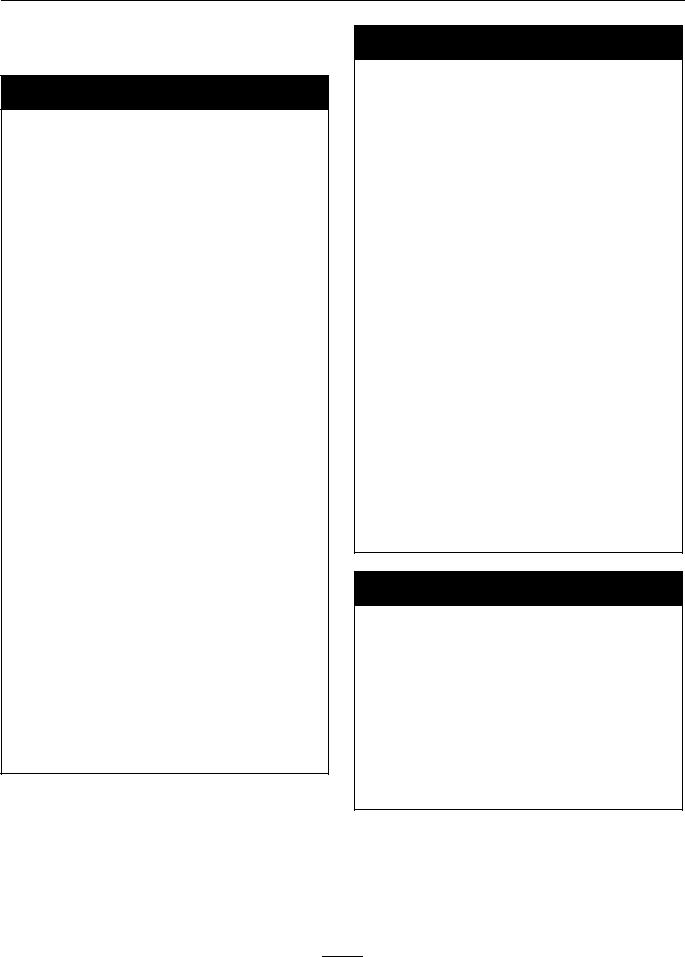
Safety
thrown by the machine and may cause personal injury to the operator or bystanders.
 DANGER
DANGER
In certain conditions gasoline is extremely flammable and vapors are explosive.
A fire or explosion from gasoline can burn you, others, and cause property damage.
•Fill the fuel tank outdoors on level ground, in an open area, when the engine is cold. Wipe up any gasoline that spills.
•Never refill the fuel tank or drain the machine indoors or inside an enclosed trailer.
•Do Not fill the fuel tank completely full. Fill the fuel tank to the bottom of the filler neck. The empty space in the tank allows gasoline to expand. Overfilling may result in fuel leakage or damage to the engine or emission system (if equipped).
•Never smoke when handling gasoline, and stay away from an open flame or where gasoline fumes may be ignited by spark.
•Store gasoline in an approved container and keep it out of the reach of children.
•Add fuel before starting the engine. Never remove the cap of the fuel tank or add fuel when engine is running or when the engine is hot.
•If fuel is spilled, Do Not attempt to start the engine. Move away from the area of the spill and avoid creating any source of ignition until fuel vapors have dissipated.
•Do Not operate without entire exhaust system in place and in proper working condition.
 DANGER
DANGER
In certain conditions during fueling, static electricity can be released causing a spark which can ignite gasoline vapors. A fire or explosion from gasoline can burn you and others and cause property damage.
•Always place gasoline containers on the ground away from your vehicle before filling.
•Do Not fill gasoline containers inside a vehicle or on a truck or trailer bed because interior carpets or plastic truck bed liners may insulate the container and slow the loss of any static charge.
•When practical, remove gas-powered equipment from the truck or trailer and refuel the equipment with its wheels on the ground.
•If this is not possible, then refuel such equipment on a truck or trailer from a portable container, rather than from a gasoline dispenser nozzle.
•If a gasoline dispenser nozzle must be used, keep the nozzle in contact with the rim of the fuel tank or container opening at all times until fueling is complete.
 WARNING
WARNING
Gasoline is harmful or fatal if swallowed. Long-term exposure to vapors has caused cancer in laboratory animals. Failure to use caution may cause serious injury or illness.
•Avoid prolonged breathing of vapors.
•Keep face away from nozzle and gas tank/container opening.
•Keep away from eyes and skin.
•Never siphon by mouth.
•If fuel is spilled on clothing, change clothing immediately.
•Check that the operator’s presence controls, safety switches, and shields are attached and
6

Safety
functioning properly. Do Not operate unless they are functioning properly.
Operation
 WARNING
WARNING
Operating engine parts, especially the muffler, become extremely hot. Severe burns can occur on contact and debris, such as leaves, grass, brush, etc. can catch fire.
•Allow engine parts, especially the muffler, to cool before touching.
•Remove accumulated debris from muffler and engine area.
•Install and maintain in working order a spark arrester before using equipment on forest-covered, grass-covered, or brush-covered unimproved land.
 WARNING
WARNING
Engine exhaust contains carbon monoxide, which is an odorless deadly poison that can kill you.
Do Not run engine indoors or in a small confined area where dangerous carbon monoxide fumes can collect.
•Operate only in daylight or good artificial light, keeping away from holes and hidden hazards.
•Be sure all drives are in neutral and parking brake is engaged before starting engine. Use seat belts with the roll bar in the raised and locked position.
•Never operate the mower with damaged guards, shields, or covers. Always have safety shields, guards, switches and other devices in place and in proper working condition.
•Never mow with the discharge deflector raised, removed or altered unless there is a grass collection system or mulch kit in place and working properly.
•Do Not change the engine governor setting or overspeed the engine.
•Stop engine, wait for all moving parts to stop, remove key and engage parking brake:
–Before checking, cleaning or working on the mower.
–After striking a foreign object or abnormal vibration occurs (inspect the mower for damage and make repairs before restarting and operating the mower).
–Before clearing blockages.
–Whenever you leave the mower.
•Stop engine, wait for all moving parts to stop, and engage parking brake:
–Before refueling.
–Before dumping the grass catcher.
 WARNING
WARNING
Hands, feet, hair, clothing, or accessories can become entangled in rotating parts. Contact with the rotating parts can cause traumatic amputation or severe lacerations.
•Do Not operate the machine without guards, shields, and safety devices in place and working properly.
•Keep hands, feet, hair, jewelry, or clothing away from rotating parts.
•NEVER carry passengers. DO NOT operate the mower when people, especially children, or pets are in the area.
•Be alert, slow down and use caution when making turns. Look behind and to the side before changing directions. Do Not mow in reverse unless absolutely necessary.
•Stop the blades, slow down, and use caution when crossing surfaces other than grass and when transporting the mower to and from the area to be mowed.
•Be aware of the mower discharge path and direct discharge away from others.
•Do Not operate the mower under the influence of alcohol or drugs.
•Use extreme care when loading or unloading the machine into a trailer or truck.
•Use care when approaching blind corners, shrubs, trees, or other objects that may obscure vision.
•Watch for traffic when operating near or crossing roadways.
7
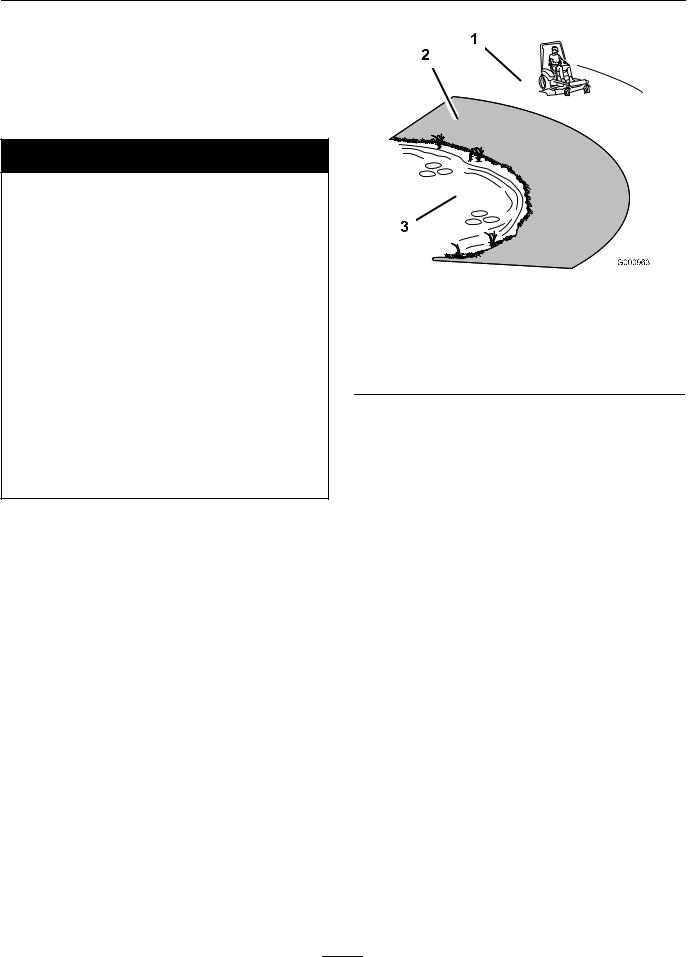
Safety
Slope Operation
Use Extreme caution when mowing and/or turning on slopes as loss of traction and/or tip-over could occur. The operator is responsible for safe operation on slopes.
 DANGER
DANGER
Operating on wet grass or steep slopes can cause sliding and loss of control. Wheels dropping over edges, ditches, steep banks, or water can cause rollovers, which may result in serious injury, death or drowning.
•Do Not mow slopes when grass is wet.
•Do Not mow near drop-offs or near water.
•Do Not mow slopes greater than 15 degrees.
•Reduce speed and use extreme caution on slopes.
•Avoid sudden turns or rapid speed changes.
•Keep the roll bar in the raised and locked position and use seat belt.
•See inside the back cover to determine the approximate slope angle of the area to be mowed.
•Use a walk behind mower and/or a hand trimmer near drop-offs, ditches, steep banks or water. (Figure 3).
Figure 3
1.Safe Zone-Use the mower here on slopes less than 15 degrees
2.Danger Zone-Use a walk behind mower and/or hand trimmer on slopes greater than 15 degrees, near drop-offs and water.
3.Water
•Remove or mark obstacles such as rocks, tree limbs, etc. from the mowing area. Tall grass can hide obstacles.
•Watch for ditches, holes, rocks, dips and rises that change the operating angle, as rough terrain could overturn the machine.
•Avoid sudden starts when mowing uphill because the mower may tip backwards.
•Be aware that operating on wet grass, across steep slopes or down hill may cause the mower to lose traction. Loss of traction to the drive wheels may result in sliding and loss of braking and steering.
•Always avoid sudden starting or stopping on a slope. If tires lose traction, disengage the blades and proceed slowly off the slope.
•Follow the manufacturer’s recommendations for wheel weights or counter weights to improve stability.
•Use extreme care with grass catchers or attachments. These can change the stability of the machine and cause loss of control.
Using the Rollover Protection System (ROPS)
A Rollover Protection System (roll bar) is installed on the unit.
8

Safety
 WARNING
WARNING
There is no rollover protection when the roll bar is down. Wheels dropping over edges, ditches, steep banks, or water can cause rollovers, which may result in serious injury, death or drowning.
•Keep the roll bar in the raised and locked position and use seat belt.
•Lower the roll bar only when absolutely necessary.
•Do Not wear seat belt when the roll bar is down.
•Drive slowly and carefully.
•Raise the roll bar as soon as clearance permits.
•Check carefully for overhead clearances (i.e. branches, doorways, and electrical wires) before driving under any objects and Do Not contact them.
•In the event of a rollover, take the unit to an Authorized Service Dealer to have the ROPS inspected.
Children
•Keep children out of the mowing area and under the watchful care of another responsible adult, not the operator.
•Be alert and turn the machine off if children enter the area.
•Before and while backing or changing direction, look behind, down, and side-to-side for small children.
•Never carry children, even with the blades off. They may fall off and be seriously injured or interfere with safe machine operation.
•Children who have been given rides in the past may suddenly appear in the mowing area for another ride and be run over or backed over by the mower.
•Never allow children to operate the machine.
Towing
•Use for towing only if equipped with an Exmark hitch kit. Do Not attach towed equipment except at the hitch point.
•Follow Exmark’s recommendation for weight limits for towed equipment and towing on slopes. This information can be found in the hitch kit instruction sheet and on the decal.
•Never allow children or others in or on towed equipment.
•On slopes, the weight of the towed equipment may cause loss of traction and loss of control.
•Travel slowly and allow extra distance to stop.
Maintenance and Storage
•Disengage drives, lower implement, set parking brake, stop engine and remove key or disconnect spark plug wire. Wait for all movement to stop before adjusting, cleaning or repairing.
•Keep engine and engine area free from accumulation of grass, leaves, excessive grease or oil, and other debris which can accumulate in these areas. These materials can become combustible and may result in a fire.
•Let engine cool before storing and Do Not store near flame or any enclosed area where open pilot lights or heat appliances are present.
•Shut off fuel while storing or transporting. Do Not store fuel near flames or drain indoors.
•Park machine on level ground. Never allow untrained personnel to service machine.
•Use jack stands to support components when required.
•Carefully release pressure from components with stored energy.
•Disconnect battery or remove spark plug wire before making any repairs. Disconnect the negative terminal first and the positive last. Reconnect positive first and negative last.
•Use care when checking blades. Wrap the blade(s) or wear gloves, and use caution when servicing them. Only replace damaged blades. Never straighten or weld them.
•Keep hands and feet away from moving parts. If possible, Do Not make adjustments with the engine running.
9

Safety
•Check for proper brake operation frequently. Adjust and service as required.
•Charge batteries in an open well ventilated area, away from spark and flames. Unplug charger before connecting or disconnecting from battery. Wear protective clothing and use insulated tools.
 DANGER
DANGER
Charging the battery may produce explosive gasses. Battery gasses can explode causing serious injury.
•Keep sparks, flames, or cigarettes away from battery.
•Ventilate when charging or using battery in an enclosed space.
•Make sure venting path of battery is always open once battery is filled with acid.
 CAUTION
CAUTION
If the ignition is in the “ON” position there is potential for sparks and engagement
of components. Sparks could cause an explosion or moving parts could accidentally engage causing personal injury
Be sure ignition switch is in the “OFF” position before charging the battery.
•Keep all guards, shields and all safety devices in place and in safe working condition.
•Check all bolts frequently to maintain proper tightness.
•Frequently check for worn or deteriorating components that could create a hazard.
 WARNING
WARNING
Removing standard original equipment parts, or using non-Exmark replacement parts and accessories may alter the warranty, traction, and safety of the machine. Failure to use original Exmark parts could cause serious injury or death.
Replace all parts including, but not limited to, tires, belts, and blades with original Exmark parts.
10
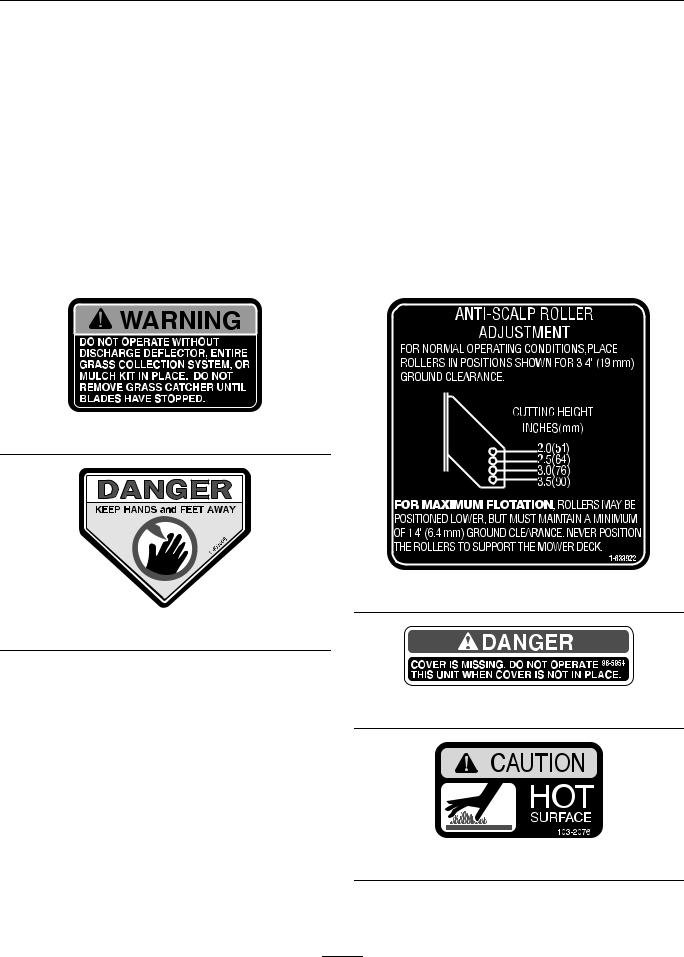
Safety
Safety and Instructional Decals
•Keep all safety signs legible. Remove all grease, dirt and debris from safety signs and instructional labels.
•Replace all worn, damaged, or missing safety signs.
•When replacement components are installed, be sure that current safety signs are affixed to the replaced components.
•If an attachment or accessory has been installed, make sure current safety signs are visible.
•New safety signs may be obtained from your authorized Exmark equipment dealer or distributor or from Exmark Mfg. Co. Inc.
•Safety signs may be affixed by peeling off the backing to expose the adhesive surface. Apply only to a clean, dry surface. Smooth to remove any air bubbles.
•Familiarize yourself with the following safety signs and instruction labels. They are critical to the safe operation of your Exmark commercial mower.
1-303508
1-633922
1-403005
98-5954
103-2076
11
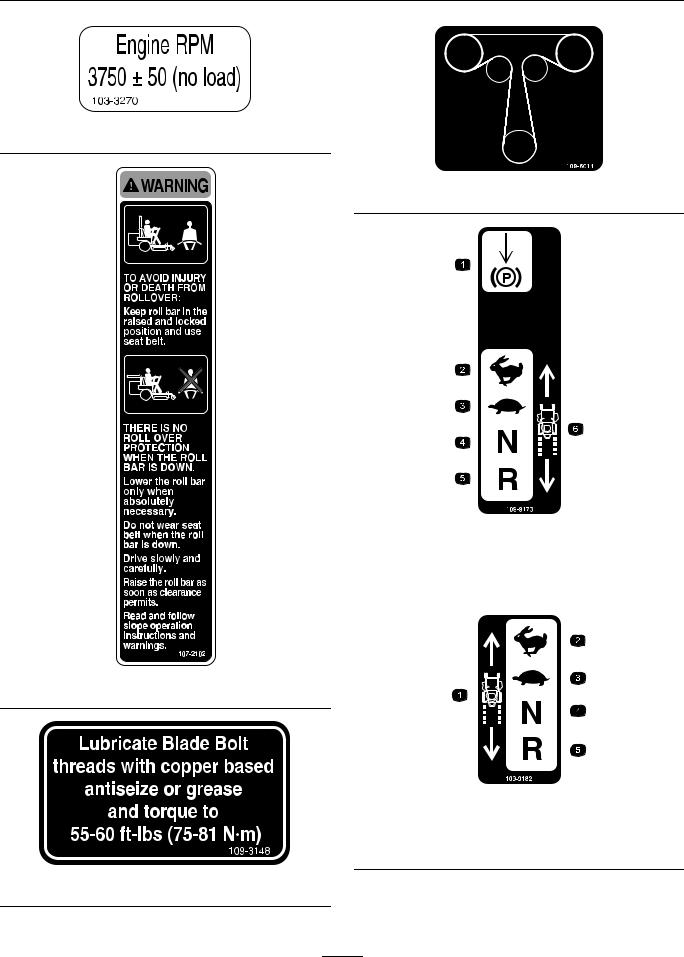
Safety
103-3270
107-2102
109-3148
109-6014
109-9173
1. |
Parking brake |
4. |
Neutral |
2. |
Fast |
5. |
Reverse |
3. |
Slow |
6. |
Machine speed |
|
|
|
|
|
|
109-9182 |
|
1. |
Machine speed |
4. |
Neutral |
2. |
Fast |
5. |
Reverse |
3.Slow
12
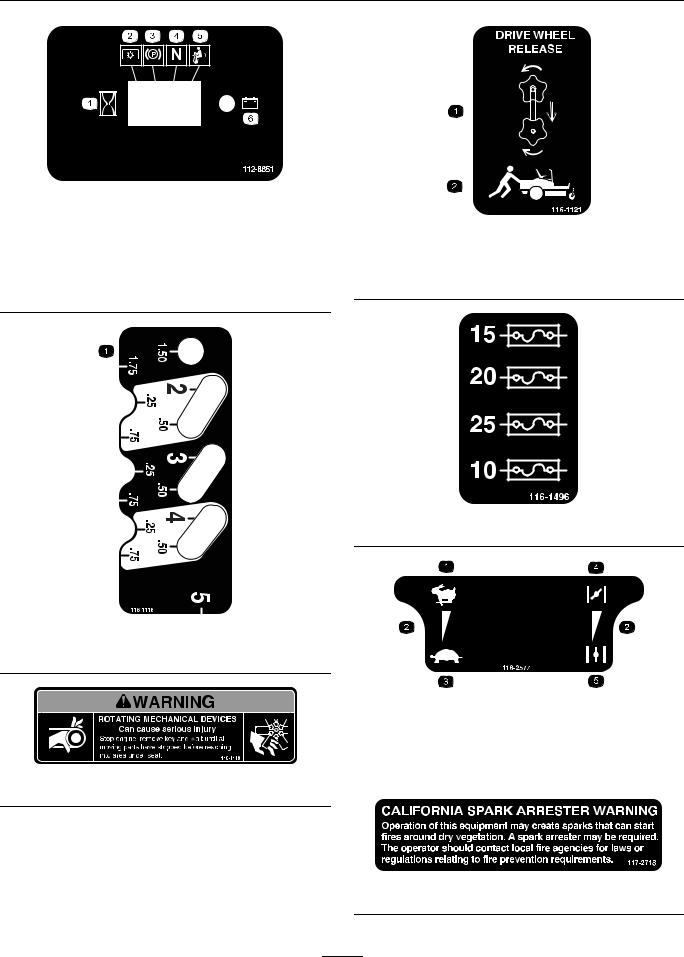
Safety
112-8651
1.Interval
2.Power Take-off (PTO)
3.Parking brake
4.Neutral
5.Operator presence switch
6.Battery
116-1118
1.Height of cut
116-1119
116-1121
1. Rotate the drive release 2. Push the machine knob to loosen, slide the
knob, and tighten
116-1496
|
|
116-2577 |
|
1. |
Fast |
4. |
Choke-on |
2. |
Continuous variable |
5. |
Choke-off |
|
setting |
|
|
3. |
Slow |
|
|
|
|
|
|
117-2718
13
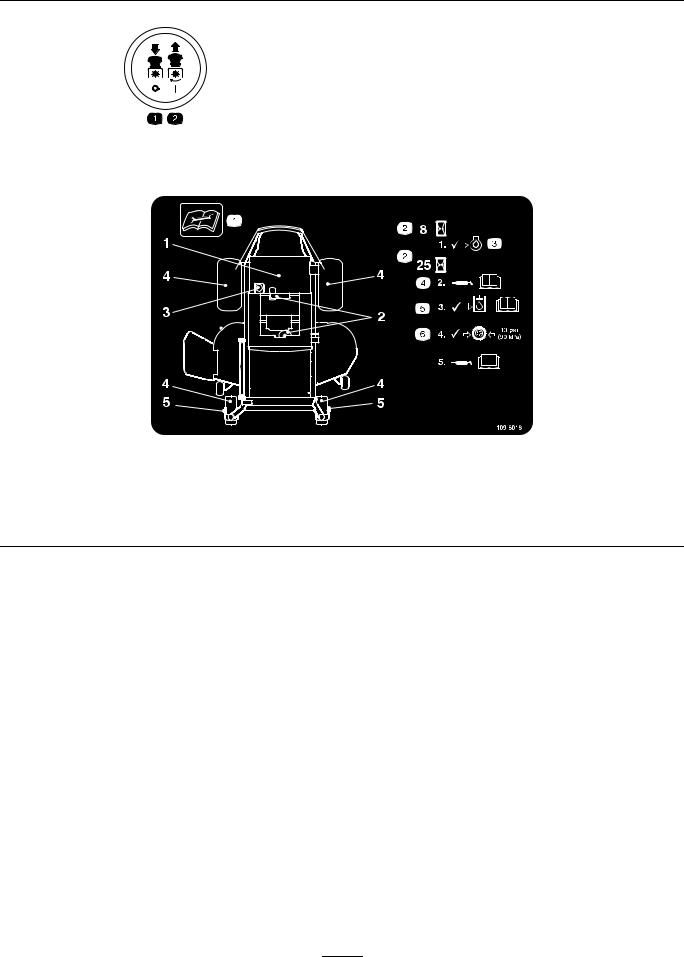
Safety
PTO Switch Symbols
1. PTO–disengage |
2. PTO–engage |
|
|||||
|
|
|
|
|
|
|
|
|
|
|
|
|
|
|
|
|
|
|
|
|
|
|
|
|
|
|
|
|
|
|
|
|
|
|
|
|
|
|
|
109-6016
1.Read the instructions before servicing or performing maintenance
2.Time interval
3.Check oil level
4.Refer to the Operator’s manual for grease instructions
5.Check hydraulic oil level and refer to the Operator’s manual for further instructions
6.Check tire pressure
14
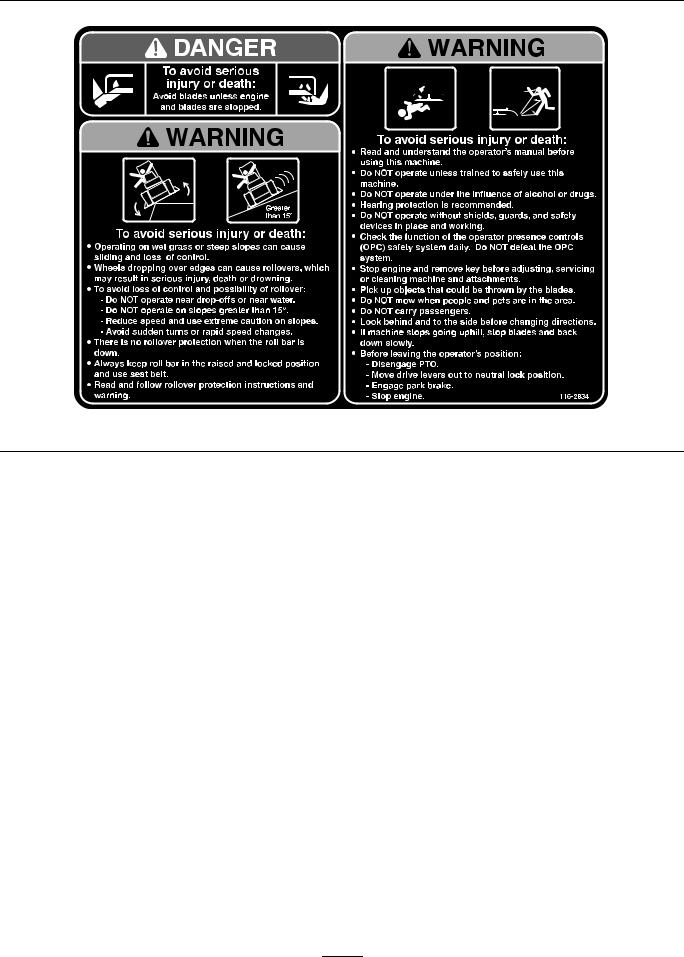
Safety
116-2834
15

Specifications
Specifications
Model Numbers
Serial Nos: 850,000 and Higher
QSP20BV443; QSP20KAS443; QSP20KAS483; QSP20KAX443; QSP22KAS523
Systems
Engine
•Engine Specifications: See your Engine Owner’s Manual
•RPM:
–20HP Briggs & Stratton
Full Speed: 3750 ±50 (max) RPM (PTO not engaged) Idle: 1650 (min) RPM
–20HP & 22HP Kawasaki
Full Speed: 3750 ±50 (max) RPM (PTO not engaged) Idle: 1550 (min) RPM
Safety Interlock System
•LCD indicators appear for the PTO, park brake, drive levers, and operator presence in the message display on the RH control panel.
•PTO must be disengaged, brake engaged, and motion control levers out (neutral lock) to start engine. (It is not necessary for the operator to be in the seat to start the engine.)
•Operator must be in seat when PTO is engaged, brake is disengaged, or motion control levers are moved in or engine will stop.
•Engine will stop if either the left, the right, or both levers are moved from neutral lock position while brake is engaged.
Fuel System
•Capacity: 4.0 gal. (15.1 L)
•Type of Fuel: Regular unleaded gasoline, 87 octane or higher; containing no more than 10% methanol or ethanol.
•Fuel Filter:
Briggs & Stratton P/N 691035 Kawasaki P/N 49019-7005
•Fuel Shut-Off Valve: 1/4 turn increments (“ON”, “OFF”)
Electrical System
•Charging System: Flywheel Alternator
•Charging Capacity: 16 amps
•Battery Type: BCI Group U1
•Battery Voltage: 12 Volt
•Polarity: Negative Ground
•Fuses: One 25 amp, one 20 amp; one 15 amp; one 10 amp blade type
•Diode: TVS
Operator Controls
•Steering and Motion Control:
Note: Motion control levers are adjustable to three heights.
–Separate levers, on each side of the console, control speed and direction of travel of the respective drive wheels.
–Steering is controlled by varying the position of the levers relative to each other.
–Moving motion control levers outward (in slots) locks the drive system in neutral.
•PTO Engagement Switch: Engages electric clutch (to drive belt) which engages mower blades.
•Parking Brake Lever: Engages parking brake.
•Deck Height Adjustment Pin: Sets cutting height to desired position.
•Deck Lift Lever: Foot pedal that raises the deck.
•Transport Lock: Automatically latches at the transport position.
Seat
•Type: Standard seat with high back, foam padded with spring suspension and armrests.
16
